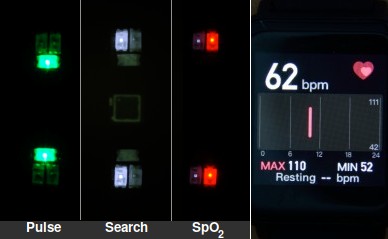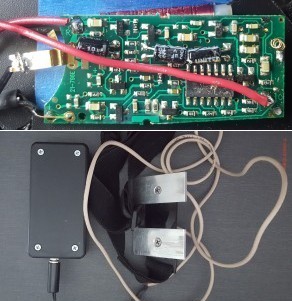 ou've heard it a million times: doctors tell you to eat your vegetables,
get plenty of sleep, and exercise. It turns out that at least for exercise
they might be on to something.
ou've heard it a million times: doctors tell you to eat your vegetables,
get plenty of sleep, and exercise. It turns out that at least for exercise
they might be on to something.
The latest research says that vigorous exercise can reduce your odds of getting cancer and prolongs the survival of patients. Vigorous exercise causes NK (natural killer cells from your innate immune system) cells and cytotoxic CD8+ T cells to be released into your blood stream where they viciously attack any cells that don't belong, including bacteria and cancer cells. Exercise also releases lymphocytes from your lymph nodes to a lesser extent (though they eventually return). This is said to be especially beneficial for patients with lymphoma, as it makes the bad cells easier to destroy.

Left LEDs on back of smartwatch. Most people notice the bright green LEDs
that measure your pulse rate. There are also two red LEDs that measure
your SpO2. Most people never notice them because they shut
off almost instantly. There are also two infrared LEDs (which appear
white), which can only be seen in an infrared camera. They flash
continuously when the watch is on to help it decide whether
you're wearing it. They also help measure SpO2. The small
square in the center is a photosensor.
Right BPM display. The graph rarely stays on long enough to show
anything more than a vertical line
Unfortunately, the human immune system is different from that of most animals, so we can't do a proper experiment; so far, it's mostly a statistical correlation. One alternative explanation might be that those patients who are less sick have enough energy to exercise more.
Another possible benefit is that exercise raises your levels of BDNF (brain-derived neurotrophic factor), which is important for your brain and theoretically might even delay the onset of Alzheimer's disease. I once worked with a brilliant junior colleague who discovered that people genetically at risk for AD have impaired BDNF processing. Unfortunately, NIH wasn't interested in that. They wouldn't fund it, so the project was abandoned. He returned to his home country where he's now a big shot at some giant institute.
BDNF causes growth of synapses, which supposedly counteracts depression. And of course there's the additional benefit of being smug, which is a side effect of exercising. Doctors would probably say being smug is good for your health. You'd know it's true because they'd get that smug look when they say it.
While bureaucratic greed and other factors have damaged the credibility of medical science in recent years, these findings seem credible. However, not every researcher sees a significant effect, so other factors could be involved. For instance, it might not work for all types of cancer.
What's the best way to monitor your pulse rate?
'Vigorous' is the operative word here. That means in order to release your NK cells and CD8+ cells, you need exercise that elevates your heart rate. Of course you also want to avoid exceeding your safe limit. So you need a heart rate monitor.
There are three basic types: the smart watch, the chest strap, and the pulse oximeter.
Smart watch
I bought a cheap Fitbit-style smart watch (Fitdock EW1). It's reasonably accurate (within ±5% or so), and these watches are designed to look inconspicuous. They're also fairly rugged: mine survived being thrown against a wall in frustration and it still worked. Some other smartwatches work better, such as the older Polar M430 (which has an LCD display that only shows the heart rate and duration), which is to say the display stays on until you turn it off, and it's big enough to read while you're jogging. As for the latest Fitbits, I haven't tested them.
The more advanced Garmin watches have night vision compatibility, multiple GNSS support, stealth mode, EKG, ballistics calculators, horizontal situation indicator course needle, a “kill switch” to erase your data in case you get captured, and (no doubt soon) missile guidance, radar jamming, and electronic warfare capabilities. (This could be very important: you wouldn't want the enemy to know your basal heart rate, for example.) These watches know when you've been sleeping. They know when you're awake. Their purpose is to make you spend a huge amount of money, thereby motivating you to keep going. But they also try to give you encouragement. For instance, my Polar says “You've reached your goal!” My goal was modest: to not die on the treadmill. So far I've reached that goal twice.

Top Heart rate monitor circuit board from inside a chest strap. As can be seen from the ferrite loop antenna at the top, this is an old model that transmits in the HF band. The red wires in upper left and lower right corner are for the right and left electrode respectively. Bottom New electrodes. For two electrodes, you get the strongest signal when they're separated by 8 cm
The green LEDs, used to measure pulse rate, measure the slight difference in light reflecting from your skin. The principle is that in the systolic phase there is a higher volume of blood in the arteries, which causes less of the light to be reflected. The red ones, used for SpO2, emit at 660 nanometers and the infrared ones emit at 990 nm. Oxygenated hemoglobin absorbs more light at 990 nm and deoxygenated hemoglobin absorbs more at 660 nm, which is why deoxygenated blood appears blue to the eye. Some watches use red LEDs for pulse rate instead of green.
The disadvantage of a smart watch is that in cheaper models the pulse display is small and hard to read in the sunlight, and it shuts off after a few seconds to conserve the battery. Shaking your wrist sometimes wakes them up and sometimes not. In bpm mode, the one I tested switches back to ‘clock’ after a few seconds. Throwing it against a brick wall doesn't help. (I tested this several times to be sure.)
I finally settled on a Garmin Forerunner 165. It's their cheapest OLED, but it works well despite the absence of a radar jammer. The display stays on when you select an exercise, though it shuts off after two minutes if you set it to Heart Monitor. An accelerometer detects when you raise your arm to look at the watch and increases the brightness. It's quite clever; I wasn't able to fool it by other arm movements. All smartwatches have an app that presumably does something, and they all want to connect to your cell phone via Bluetooth, but they still work without it.
Update The Garmin has another nice feature: it goes into Power Save mode after 25 minutes. This is very convenient: if you die while jogging, the next jogger who comes along to steal the watch off your dead body doesn't have to find a USB-C port to charge it back up. It also vibrates if it thinks your heart rate is too high. I turn this off. I don't need it: vultures are always circling overhead whenever I'm outside to remind me. To them a jogger is just another animal in distress.
Chest strap
Most chest straps measure your heart rate electrically. The rubber straps contain electrodes that require perspiration in order to make contact with the skin. (EKG electrode gel is inexpensive and can help.) The strap contains a small radio transmitter that sends a signal to a display on your exercise machine or treadmill.
One problem is that the rubber disintegrates after a few years. If the transmitter still works, you can save it by soldering wires to the two points on the circuit board labeled L and R, make new electrodes from one-inch-square pieces of aluminum, and put them in a new strap. With the transmitter and battery in a box (see photo), this worked as well as the original, which is to say the strap tended to slide down from all the stomping around and occasionally missed beats, making the reading less accurate (though the machine takes this into account). It also looks a bit like a homemade bomb, so you wouldn't want to wear this running down the street.
I also tried some of those Red Dot stick-on electrodes, which worked perfectly while I was standing still. But as soon as I started to sweat, they fell off. That may be why nurses tell you not to run around the hospital room while you're hooked up to a monitor. (There must be some way around this, as doctors use them for stress tests.)

Pulse-oximeter display This Oxline AOJ-70B is ten grams heavier than the Zacurate, which makes it more of a challenge to use while jogging. It gives a warning beep if your SpO2 goes below 95%. It's also supposed to give a warning if your heart stops altogether, although I haven't tested that feature yet. The Zacurate 500DL is better for exercising, as it's lighter and stays on your finger longer before falling off and getting run over by a passing car. The display is also easier to read
Pulse oximeter
If all you want is your pulse rate and you don't need a thousand-dollar smart watch with GPS to figure out a route for you, a pulse oximeter is ideal. The Zacurate 500DL displays your heart rate and blood oxygen saturation (SpO2) continuously in a readable red LED display. Others, like the one shown, have a color display and a configurable plot of your heart rate. Unlike a smart watch, it continues to work until you take it off. It's more accurate than any watch but doesn't work if your hands are cold. SpO2 is a valuable reminder: if it's too low, you're not breathing enough. The AAA batteries need frequent replacement. If they're more than half dead the bpm readings jump randomly, in my case from 60 to 200. It will also give inaccurate readings if your hand moves too much.
I recommend wearing at least two devices at all times, since sooner or later one of them is going to go into Power Save, change into iTunes mode, or stop working altogether.
Stopwatch
Or you could take your pulse with a stopwatch like a normal person. But that's doing it the easy way. Exercising is no fun at all without electronic gadgets to take apart to see how they work.
sep 02 2024, 9:50 am. last updated oct 28, 2024. new oximeter image added jan 26, 2025
